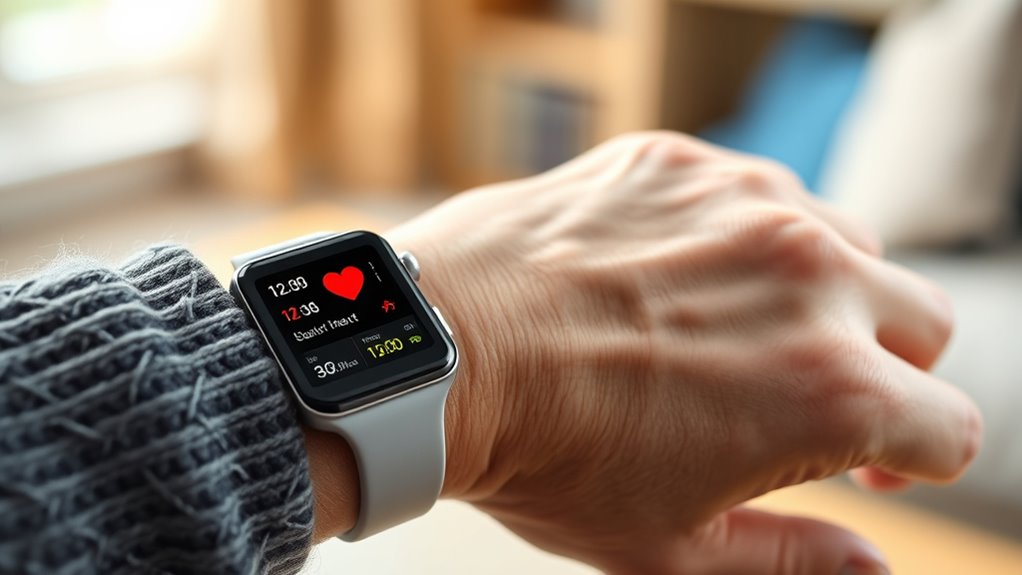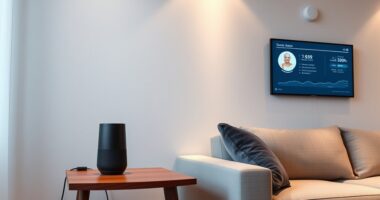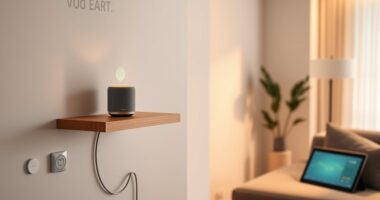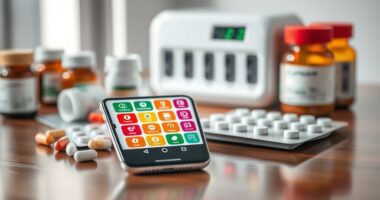Wearable health tech for elderly adults includes stylish devices like smartwatches, fitness trackers, and pendant alerts that combine fashion with safety. These devices offer features such as fall detection, emergency alerts, health monitoring, and location tracking to support independence and quickly respond to emergencies. They also help manage chronic conditions and promote mental well-being. To discover more about choosing the right device and future innovations, keep exploring how these technologies can enhance your quality of life.
Key Takeaways
- Wearable health tech for seniors includes stylish devices like smartwatches, fitness trackers, and pendant alerts that combine aesthetics and functionality.
- Core features such as fall detection, emergency alerts, and vital sign monitoring support safety and health management for elderly users.
- Location tracking and instant emergency response capabilities enable quick assistance, promoting independence and peace of mind.
- Privacy and data security are crucial, with devices offering customizable settings and secure data sharing with healthcare providers.
- Future innovations focus on smarter sensors, longer battery life, AI alerts, and seamless integration with smart home systems for enhanced elder care.
Types of Wearable Devices for Seniors
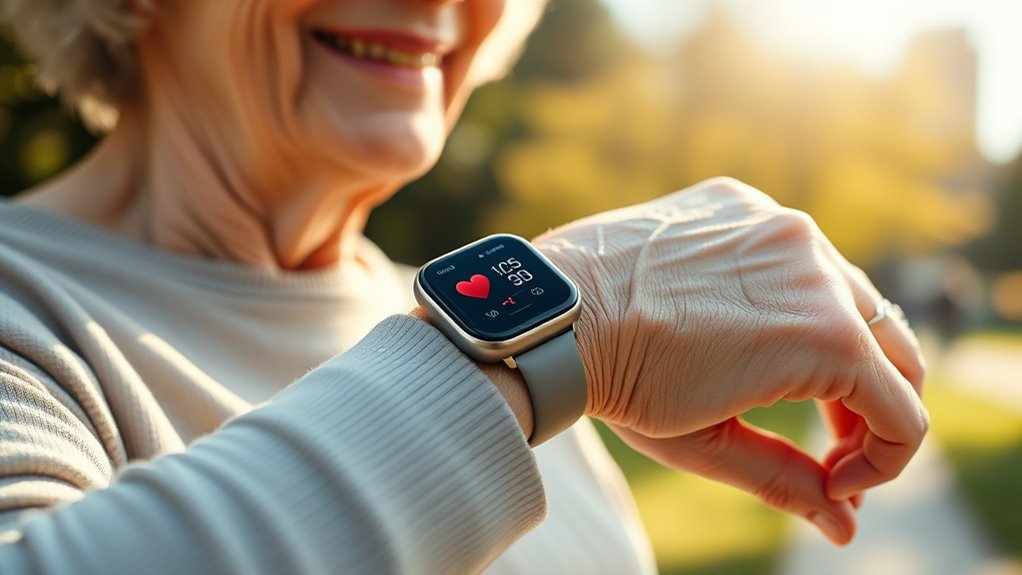
There are several types of wearable devices designed specifically for seniors, each serving different health and safety needs. These devices come in various styles that prioritize fashion aesthetics, so you can choose something that fits your personal taste without sacrificing function. Whether you prefer a sleek smartwatch, a discreet fitness tracker, or a pendant-style medical alert, there’s something for everyone. Battery life is also a key consideration; some devices last several days on a single charge, reducing the hassle of frequent recharging. This ensures you stay connected and monitored without interruptions. Additionally, many devices incorporate environmental considerations, such as water resistance and durability, to support active lifestyles. Some options are designed with aesthetic versatility, allowing wearers to match their device with different outfits and occasions. Furthermore, selecting a device with reliable health data capabilities can help monitor vital signs and provide timely alerts in case of emergency. As the integration of AI in healthcare continues to grow, these devices are becoming more sophisticated and effective. Incorporating user-friendly interfaces is essential for ensuring that seniors can easily operate their devices without frustration. With a wide range of options, you can find a wearable that matches your lifestyle, keeps you safe, and looks good, all while providing reliable health data.
Key Features Beneficial to Elderly Users
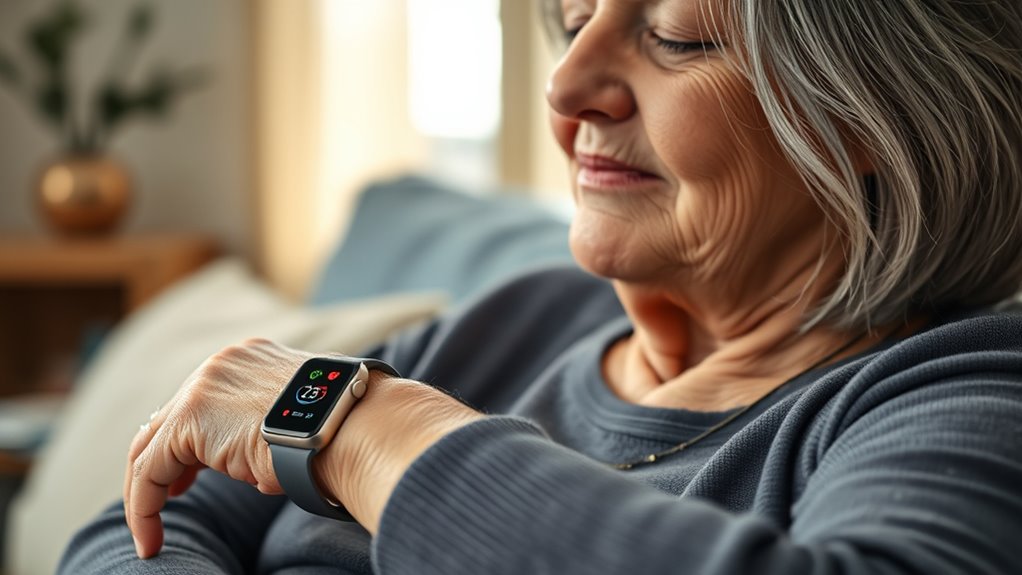
You’ll find that features like fall detection and emergency alerts can make a big difference in staying safe. These tools provide quick help when needed, giving you peace of mind. Additionally, health monitoring features help track essential signs, so you and your loved ones stay informed about your well-being. For optimal safety and effectiveness, choosing vetted wearable health tech options is highly recommended. Incorporating meditation and relaxation features can also support mental well-being, promoting overall health and resilience. Understanding the importance of waterproof design can ensure devices remain functional in various conditions, enhancing reliability and user confidence. Moreover, selecting devices with accurate sensors can improve the reliability of health data collected, especially as advancements in AI in Business continue to enhance data analysis and personalized care.
Fall Detection Capabilities
Fall detection is a crucial feature in wearable health tech for elderly adults, providing immediate alerts when a fall occurs. This feature helps guarantee quick assistance, reducing injury risks. By monitoring falls, your device can also support social engagement by reassuring loved ones that you’re safe, encouraging more active social participation. Additionally, knowing that falls are detected and responded to promptly can improve your sleep quality, as you won’t worry about unnoticed accidents overnight. These devices often use accelerometers and gyroscopes to accurately identify falls, minimizing false alarms. When a fall happens, alerts are instantly sent to caregivers or family members, ensuring help arrives swiftly. Regular maintenance and understanding of device safety features can further enhance their effectiveness. Furthermore, advancements in wearable technology have increased the accuracy of fall detection systems, making these devices more reliable than ever. Incorporating user-friendly interfaces also helps elderly users operate these devices more effectively. Utilizing advanced sensors can further improve detection accuracy, providing added reassurance for users and their families. Moreover, continuous improvements in device calibration contribute to more precise fall detection, increasing overall confidence in the system. Overall, fall detection enhances safety, promotes peace of mind, and encourages a more active, connected lifestyle for elderly users.
Emergency Alert Systems
Emergency alert systems in wearable health devices provide elderly users with a reliable way to summon help quickly during emergencies. When an emergency occurs, these systems enable you to press a button or use voice commands to alert caregivers or emergency services promptly. Device durability is vital, ensuring the device withstands daily wear and tear, and remains functional in various environments. Additionally, incorporating sustainable grooming practices can extend the lifespan of wearable devices, making them more eco-friendly and reducing electronic waste. These practices might include choosing devices made from durable materials that resist damage over time. Moreover, selecting devices with long-lasting batteries can minimize the need for frequent replacements, further promoting sustainability. Ensuring that the device’s design incorporates Vetted safety features is crucial for reliable performance in critical moments. Incorporating advanced fraud detection techniques in device security can help protect sensitive health data transmitted during emergencies. However, privacy concerns can arise, as these systems often transmit sensitive health data and location information. It’s essential to choose devices that prioritize data security and offer user control over privacy settings. A well-designed emergency alert feature enhances safety, giving you peace of mind knowing help is accessible at all times, without sacrificing device resilience or privacy.
Health Monitoring Features
What key health monitoring features make wearable devices particularly beneficial for elderly users? These features track vital signs like heart rate, blood pressure, oxygen levels, and activity patterns, providing real-time insights. They help you stay alert to potential health issues before they become serious. To maximize benefits, guarantee the device offers robust data privacy, protecting sensitive health info. Compatibility with your existing devices and apps ensures seamless integration and easy access to your data. Here are some essential features to look for:
- Continuous vital sign monitoring
- Alerts for abnormal readings
- Secure data privacy protocols
- Broad device compatibility
These features empower you to manage your health proactively while maintaining control over your personal data.
How Wearable Tech Supports Chronic Disease Management
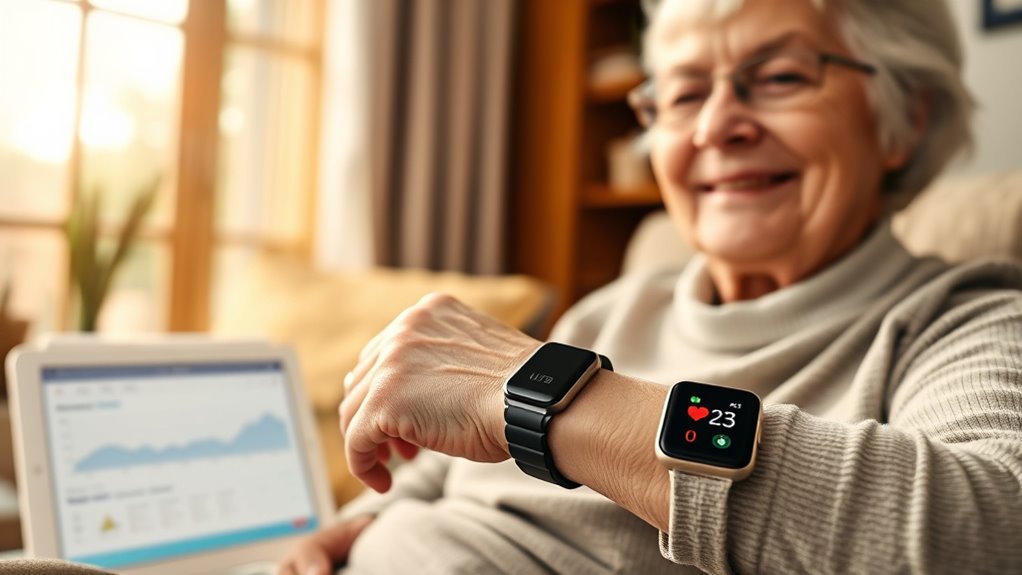
Wearable health technology plays an essential role in helping elderly adults manage chronic diseases more effectively. By continuously tracking critical signs like blood pressure, glucose, and heart rate, these devices provide real-time data that you can share with healthcare providers. This promotes timely interventions and personalized care. Additionally, research supports the integration of wearable health tech into routine healthcare, enhancing overall management strategies. It is also important to recognize the subtle energy shifts that may occur during health monitoring, which can influence overall well-being. However, privacy concerns remain, especially regarding data security and consent. Additionally, data interoperability is essential; devices must seamlessly communicate with various health systems for integrated management. The development of standardized communication protocols is crucial to ensure compatibility across different devices and platforms. Moreover, aligning these devices with existing healthcare infrastructure can facilitate smoother adoption and more comprehensive patient care. To highlight this, consider the following:
| Benefit | Challenge |
|---|---|
| Continuous health monitoring | Privacy concerns |
| Real-time alerts | Data interoperability issues |
| Personalized treatment plans | Data security risks |
| Improved patient engagement | Compatibility limitations |
| Better chronic disease control | Data fragmentation |
This synergy helps you stay proactive in managing your health effectively. Effective integration of wearable devices with healthcare systems is crucial to maximize their benefits.
Enhancing Safety and Emergency Response With Wearables
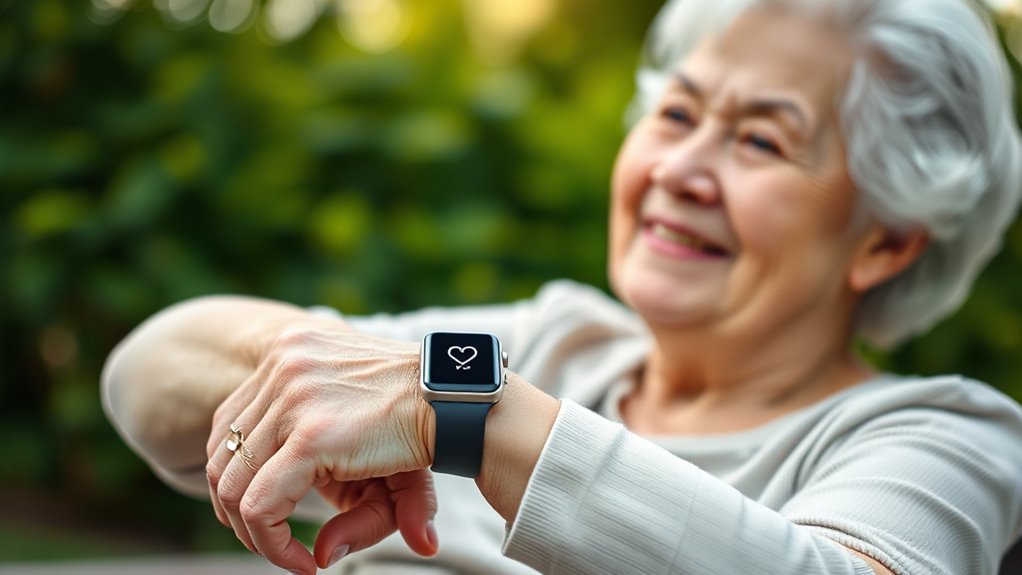
Wearable devices can substantially boost safety by providing fall detection technology and emergency alert systems that notify loved ones or caregivers instantly. With real-time location tracking, you can quickly find and assist someone in need, even if they’re unable to call for help. These features work together to create a safer environment and faster emergency responses for elderly adults.
Fall Detection Technology
Fall detection technology has become a essential feature in wearable health devices for elderly adults, markedly improving safety and emergency response times. It uses sensors to identify sudden movements or impacts indicating a fall, alerting caregivers immediately. To better understand its significance, consider:
- How quick alerts can prevent serious injuries or complications.
- The balance between privacy concerns and safety benefits.
- Compatibility across various devices and platforms.
- The need for reliable sensors to reduce false alarms.
When choosing a device, ensure it addresses privacy concerns and offers seamless device compatibility. Fall detection tech boosts confidence, allowing seniors to maintain independence while ensuring help arrives swiftly if needed. It’s a crucial step toward safer aging with wearable technology.
Emergency Alert Systems
How quickly emergency alerts are dispatched can make the difference between a minor incident and a serious health crisis. Wearable emergency alert systems guarantee you can summon help immediately, often with the press of a button or automatically during a fall. These devices are customizable, allowing you to set preferred contacts or emergency services. However, privacy concerns are valid, as some systems transmit sensitive health data or location information. To address this, choose devices that prioritize data security and offer adjustable privacy settings. Proper device customization helps you balance safety and privacy, ensuring alerts are sent efficiently without unnecessary data sharing. With reliable, tailored emergency systems, you gain peace of mind knowing help is just moments away when needed most.
Real-Time Location Tracking
Real-time location tracking considerably boosts safety and emergency response for elderly adults by providing immediate, accurate position data. This technology allows caregivers and emergency services to quickly locate someone in distress or lost. However, privacy concerns arise as sensitive location data is shared, so choosing devices with strong security features is vital. Compatibility also matters; verify the wearable works seamlessly with existing smartphones or monitoring systems. To maximize benefits, consider:
- How data is stored and protected
- Device compatibility with your current tech
- Emergency alert integration
- User-friendly interfaces for elderly adults
Choosing the Right Wearable for Your Needs

Choosing the right wearable for your needs depends on understanding your specific health goals and daily routines. Consider factors like cost considerations and user comfort to guarantee the device fits seamlessly into your life. If budget is a concern, look for affordable options with essential features. Prioritize user comfort by selecting a device that’s lightweight, adjustable, and non-intrusive, especially if you’ll wear it all day. Use this table to compare ideas:
| Feature | Consideration |
|---|---|
| Cost considerations | Balance price with necessary features |
| User comfort | Lightweight, adjustable, non-irritating |
| Functionality | Track vital signs, activity, or medication reminders |
Future Trends in Elderly-Focused Wearable Health Technology
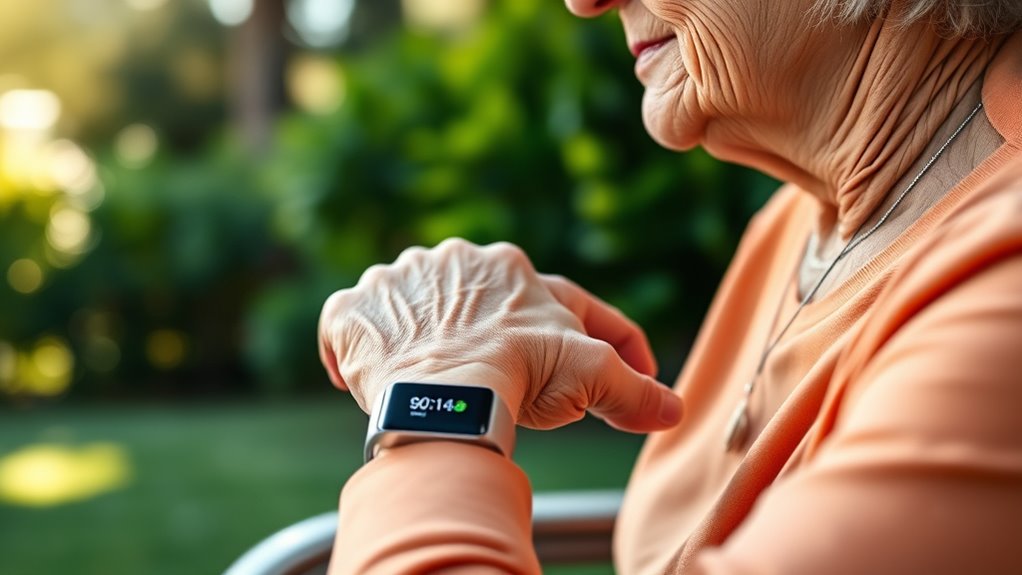
As technology continues to evolve, the future of elderly-focused wearable health devices looks promising, with innovations aimed at enhancing independence and safety. Expect smarter sensors that provide real-time health insights and AI-driven alerts for early warning signs. Advanced wearables will become more seamless, blending into everyday life while maintaining robust data security. However, privacy concerns remain a priority. You’ll see developments like encrypted data transmission and user-controlled privacy settings to protect sensitive information. Additionally, future trends include personalized health coaching, integration with smart home systems, and improved battery life. These advancements will help you stay healthy and secure while addressing potential data security issues, empowering you to manage your health confidently and privately.
- Smarter AI health alerts
- Enhanced data security measures
- Seamless device integration
- Personalized health coaching
Frequently Asked Questions
How Affordable Are Wearable Health Devices for Most Seniors?
When considering the cost comparison and affordability factors, you’ll find that wearable health devices vary widely in price. Some models are budget-friendly, making them accessible for most seniors, while others offer advanced features at a higher cost. Your best approach is to evaluate features you need versus what fits your budget. Often, discounts or simpler models help improve affordability, ensuring you get valuable health insights without overspending.
What Privacy Concerns Exist With Elderly Wearable Health Tech?
Oh, the irony is rich—trust your device with your health data, but worry about privacy? You might be concerned about data security breaches or how your consent is managed. Elderly users should stay alert to these risks, ensuring their personal information isn’t exploited. Always check the device’s privacy policies and control settings, so you’re aware of how your data is handled and who has access.
Are Wearable Devices Suitable for Seniors With Cognitive Impairments?
You might wonder if wearable devices suit seniors with cognitive impairments. These devices can aid in cognitive assessment and provide memory support, making daily life easier. They offer real-time monitoring and alerts, helping caregivers stay informed. However, guarantee the tech is simple to use and suits individual needs. Proper training and ongoing support are essential to maximize benefits and ensure comfort for seniors facing cognitive challenges.
How User-Friendly Are Wearable Health Devices for Seniors With Limited Tech Experience?
Did you know that 60% of seniors find new technology difficult to use? When it comes to usability challenges, wearable health devices often seem complicated for those with limited tech experience. However, design simplicity can markedly improve their experience. Clear interfaces, large buttons, and straightforward functions help seniors feel more confident. With thoughtful design, these devices become easier to navigate, ensuring better health management and independence for elderly users.
What Support Options Are Available if a Senior Encounters Device Issues?
If you encounter device issues, you have several support options. Many companies offer dedicated tech support through phone, chat, or email, making troubleshooting easier. Additionally, they often provide troubleshooting resources like FAQs, user manuals, and online tutorials. You can also visit local stores or authorized service centers for hands-on help. These options guarantee you get the assistance needed to stay connected and make the most of your wearable health tech.
Conclusion
Imagine a wearable device as a trusted companion, always there like a lighthouse guiding you safely through life’s storms. With these technologies, you can stay connected, monitor health, and respond quickly in emergencies—empowering you to navigate aging with confidence. As more seniors embrace wearable health tech, it’s like planting a sturdy tree that grows stronger each year, offering protection and peace of mind for you and your loved ones.
